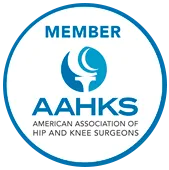Frequently Asked Questions.

Whether you are researching ways to manage joint pain or preparing for a surgical procedure, the answers to these frequently asked questions (FAQs) can provide essential information on what to expect. It can be easier to make informed medical decisions if you familiarize yourself with what other patients in your position are asking about.

How do I know if I’m a candidate for joint replacement surgery?
You may be a good candidate for joint replacement surgery if you experience substantial pain or mobility obstructions that interrupt your daily activities, even after trying non-surgical treatments like pulsed electromagnetic field therapy. Still, a thorough evaluation and medical imaging from a qualified joint specialist is the best way to confirm if surgery is the right option for you.
What types of joint replacement surgeries do you offer?
The joint replacement surgeries we offer are:
- Total hip revision surgery
- Anterior total hip replacement
- Total knee replacement
- Partial knee replacement
- Total knee replacement revision
Each surgical approach is tailored to the specific needs and conditions of the patient. We also offer non-surgical alternative therapies to manage pain and inflammation.
What is the recovery time for joint replacement surgery?
Recovery timelines vary based on the patient’s age, quality of health, and the type of surgery they receive. Still, most patients get to go home shortly after their surgery, thanks to the minimally invasive technology we use, such as Mako SmartRobotics. Then, most patients will experience significant improvements in mobility and pain within the first few weeks of recovery, and they can resume everyday tasks with slight adjustments within six months.
How long does a joint replacement last?
A replaced joint can last between 15 to 20 years for many patients. Still, the longevity of a prosthetic joint depends on the bodily location, such as the knee or hip, and lifestyle factors, such as the patient’s activity level or body weight.
What should I expect during rehabilitation after surgery?
Although each rehabilitation plan is unique, they should each include medication for pain relief, check up visits, and some level of physical therapy to improve strength, flexibility, and mobility. You can expect a structured program starting with gentle exercises and progressing to more intensive workouts. Physical therapy should concentrate on the muscles surrounding your new joint to help you regain function and return to daily activities.
Are there non-surgical alternatives to joint replacement?
Yes, some non-surgical alternative therapies that are available to help with joint pain and mobility issues include:
- Pulsed electromagnetic field therapy
- ARPwave therapy
- Physical therapy
- Prescription medications
- Corticosteroid injections
Making intentional lifestyle changes, such as controlling your body weight to reduce strain on your joints, can help you manage pain and improve joint function. Considering these options before opting for surgery is always a good idea.
Will I need physical therapy after joint replacement surgery?
Yes, physical therapy is an essential part of the recovery process. Its focus is to help restore range of motion, strengthen muscles around the joint, and improve overall function.
How can I prepare for joint replacement surgery?
Preparation involves attending pre-surgical assessments, learning about the procedure and recovery process, adapting your home to meet your new mobility needs, arranging for post-surgery assistance from friends, family, or caretakers, and following preoperative instructions given by your healthcare provider.
Does insurance cover joint replacement surgery?
Many insurance plans offer coverage for joint replacement surgery, but it depends on the details of the health plan. It is essential to check with your insurance company and the medical provider to understand the specifics of your policy and predict potential out-of-pocket expenses.
What are the benefits of robotic-assisted surgery?
Robotic-assisted surgery like Mako SmartRobotics can reduce the procedure’s invasiveness by offering superb precision when making incisions and interacting with joint components. Some potential benefits of robotic-assisted surgery include less pain, a mitigated risk of complications, and a quicker recovery compared to traditional methods.
Can I swim?
You can swim 2 weeks after surgery.
When I can drive?
Each patient is different and it depends on which leg was operated on but generally when:
- You are not taking narcotics during the day
- You can comfortably get in on the drivers side
- You feel you are strong enough to get from the gas to the brake quickly enough to avoid an accident
When can I golf?
Typically 6 weeks after surgery.
When can I fly?
You can fly 2 weeks after surgery, but with precautions. You are at risk for a blood clot for 3 months after surgery. If you fly during this time you should be on aspirin 81 mg twice a day or a stronger blood thinner for air travel.
Will I set off metal detectors?
Your hip may set off the metal detectors. Always budget extra time when visiting a location with metal detectors. If you do set off the detector, notify the TSA agent that you have a joint replacement. Airports no longer accept implant cards as proof and will still require you to undergo screening.
What activities will I be allowed to do after I am healed?
Most patients can return to all activities 3 months after surgery although full healing can take up to 1 year. However, high impact activities such as running can lead to early wear of the joint and should be avoided.
What are the extra pin holes for?
The pin sites are where Dr. Martin attaches the robotic trackers. No hardware is retained at the site.
What does the Robot do and why do I need a CT scan?
The robot provides accuracy and precision in order to improve on the results of traditional joint replacement. Dr. Martin is present at all times during the surgery and is working in conjunction with the robot. The CT scan allows Dr. Martin to create a digital 3D model of your joint to template your surgery and ensure accurate bone prep and implant position.
Returning to work after surgery?
Time off varies depending on how physically demanding your work is
- For physically demanding jobs 6 weeks
- For desk or seated jobs 2 weeks
Why are there fees for work forms?
Work forms require a significant amount of staff resources and are not reimbursed by insurance.
How many procedures has Dr. Martin performed?
Dr. Martin has successfully performed over 5000 robotic joint replacements since 2009.
Why can’t I have a handicapped placard after surgery?
Dr. Martin encourages walking as part of your recovery. You should take every opportunity to use your new joint.
What are the implants made of?
Ceramic, titanium, and polyethylene plastic. Some hip replacements have additional cobalt chrome or bone cement which is methyl methacrylate. Dr. Martin does not use metal on metal implants. If you have a nickel allergy and were provided a specialized implant it is typically made with ceramic or oxinium, titanium, and polyethylene plastic.
Can I swim?
You can swim 2 weeks after surgery.
When I can drive?
Each patient is different and it depends on which leg was operated on but generally when:
- You are not taking narcotics during the day
- You can comfortably get in on the drivers side
- You feel you are strong enough to get from the gas to the brake quickly enough to avoid an accident
When can I golf?
Typically 4 weeks after surgery.
When can I fly?
You can fly 2 weeks after surgery, but with precautions. You are at increased risk for a blood clot for 3 months after surgery. If you fly during this time you should be on aspirin 81 mg twice a day or a stronger blood thinner for air travel.
Will I set off metal detectors?
Your knee will likely set off the metal detectors. Always budget extra time when visiting a location with metal detectors. If you do set off the detector, notify the TSA agent that you have a joint replacement. Airports no longer accept implant cards as proof and will still require you to undergo screening.
What activities will I be allowed to do after I am healed?
Most patients can return to all activities 3 months after surgery although full healing can take up to 1 year. However, high impact activities such as running can lead to early wear of the joint and should be avoided.
What are the extra pin holes for?
The pin sites are where Dr. Martin attaches the robotic trackers. No hardware is retained at the site.
What does the Robot do and why do I need a CT scan?
The robot provides accuracy and precision in order to improve on the results of traditional joint replacement. Dr. Martin is present at all times during the surgery and is working in conjunction with the robot. The CT scan allows Dr. Martin to create a digital 3D model of your joint to template your surgery and ensure accurate bone prep and implant position.
Returning to work after surgery?
Time off varies depending on how physically demanding your work is
- For physically demanding jobs 6 weeks
- For desk or seated jobs 2 weeks
Why are there fees for work forms?
Work forms require a significant amount of staff resources and are not reimbursed by insurance.
How many procedures has Dr. Martin performed?
Dr. Martin has successfully performed over 5000 robotic joint replacements since 2009.
Why can’t I have a handicapped placard after surgery?
Dr. Martin encourages walking as part of your recovery. You should take every opportunity to use your new joint.
What are the implants made of?
Cobalt chrome, titanium, and polyethylene plastic. Some knees have bone cement which is methyl methacrylate. If you have a nickel allergy and were provided a specialized implant it is typically made with ceramic or oxinium titanium, and polyethylene plastic.
Can I swim?
You can swim 2 weeks after surgery.
When I can drive?
Each patient is different and it depends on which leg was operated on but generally when:
- You are not taking narcotics during the day
- You can comfortably get in on the drivers side
- You feel you are strong enough to get from the gas to the brake quickly enough to avoid an accident
When can I golf?
Typically 6 weeks after surgery.
When can I fly?
You can fly 2 weeks after surgery, but with precautions. You are at risk for a blood clot for 3 months after surgery. If you fly during this time you should be on aspirin 81 mg twice a day or a stronger blood thinner for air travel.
Will I set off metal detectors?
Your knee will likely set off the metal detectors. Always budget extra time when visiting a location with metal detectors. If you do set off the detector, notify the TSA agent that you have a joint replacement. Airports no longer accept implant cards as proof and will still require you to undergo screening.
What activities will I be allowed to do after I am healed?
Most patients can return to all activities 3 months after surgery although full healing can take up to 1 year. However, high impact activities such as running can lead to early wear of the joint and should be avoided.
What are the extra pin holes for?
The pin sites are where Dr. Martin attaches the robotic trackers. No hardware is retained at the site.
What does the Robot do and why do I need a CT scan?
The robot provides accuracy and precision in order to improve on the results of traditional joint replacement. Dr. Martin is present at all times during the surgery and is working in conjunction with the robot. The CT scan allows Dr. Martin to create a digital 3D model of your joint to template your surgery and ensure accurate bone prep and implant position.
Returning to work after surgery?
Time off varies depending on how physically demanding your work is
- For physically demanding jobs 6 weeks
- For desk or seated jobs 2 weeks
Why are there fees for work forms?
Work forms require a significant amount of staff resources and are not reimbursed by insurance.
How many procedures has Dr. Martin performed?
Dr. Martin has successfully performed over 5000 robotic joint replacements since 2009.
Why can’t I have a handicapped placard after surgery?
Dr. Martin encourages walking as part of your recovery. You should take every opportunity to use your new joint.
What are the implants made of?
Cobalt chrome, titanium, and polyethylene plastic. Some knees have bone cement which is methyl methacrylate. If you have a nickel allergy and were provided a specialized implant it is typically made with ceramic or oxinium titanium, and polyethylene plastic.
Bringing Excellence Home
Our Location
20401 N. 73rd St., Suite 160
Scottsdale, AZ 85255
Office Hours
Monday through Friday
8:00 am – 4:00 pm








